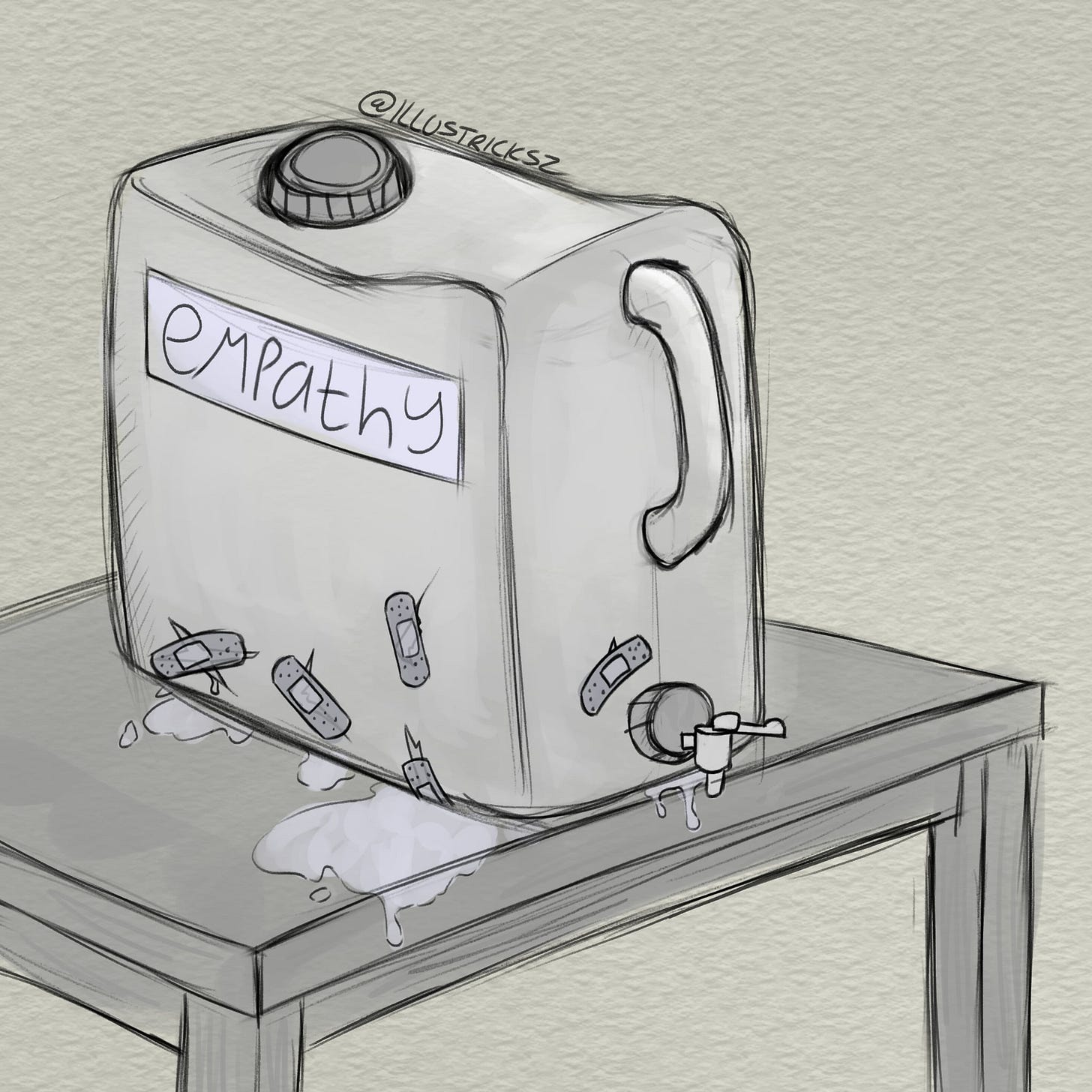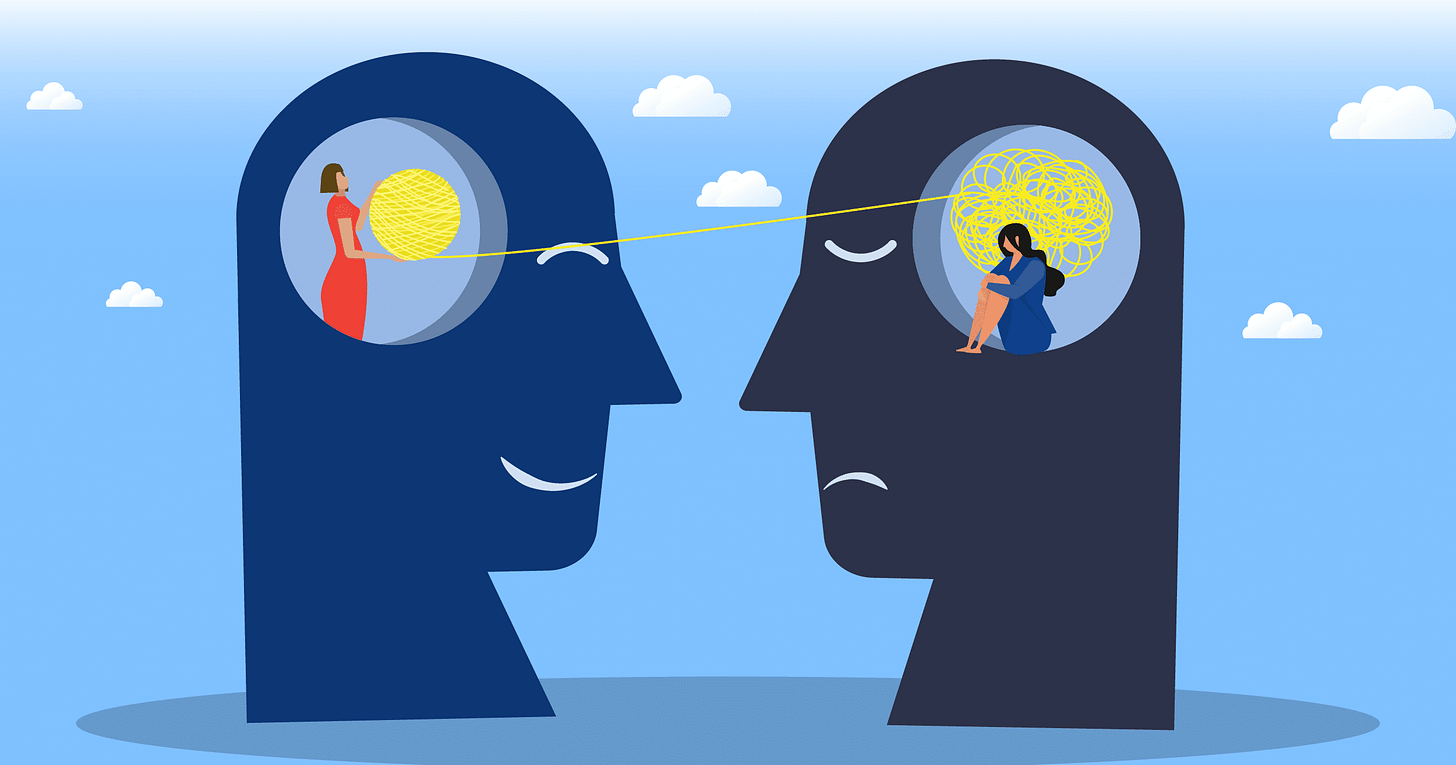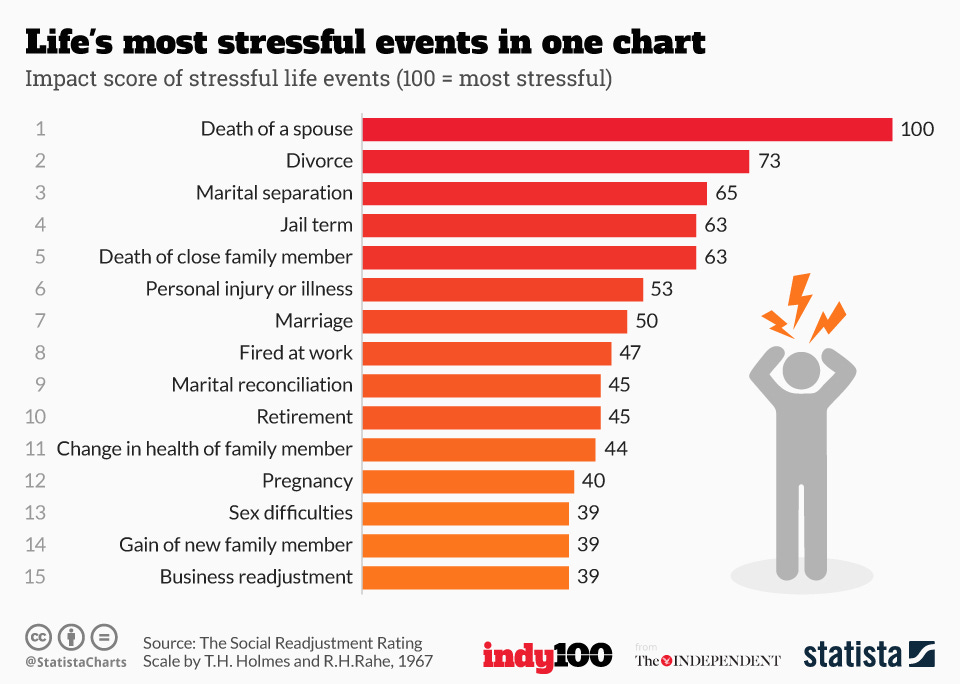The Empathy Tank - What is it? How does it work? What can we do when it leaks?
Empathy is a finite resource, and part of a system that usually works without much thought... until it doesn't. Patching leaks in our Empathy Tank is part of the solution.
I've explored empathy here in my writing a few times and referenced an ‘Empathy Tank’ on a few occasions… but I haven’t explained the metaphor yet.
The image is finally clear enough to share, so today I'll try to explain what I call “The Empathy Tank.”
This may be considered "speculative discourse." I am not a medical or mental health professional.1 I am trying to explain a natural human act/emotion as a system we rarely consider. I'm painting a picture to make sense of something we take for granted... something that is usually second nature for most of us most of the time… but sometimes isn’t for some of us.
Wielding empathy effectively became a recurring struggle for me, particularly toward the later part of my military career. I determined that tends to manifest as being blunt and judgmental, and that’s something I’m trying to address.
Part of why my empathy tank was empty: I poured it all out at the end of my career.
I say that with no sense of accomplishment, regrets, or hard feelings, just a simple acknowledgment.
Over the last couple years, and certainly the last few months of my career, I poured out everything I had all over the place - my energy, my focus, and my empathy. Preparing for retirement and a move across the planet added to the intensity, and the entire process was oddly challenging.
After travelling this road on Substack for a while, I can now see how some of those challenges may have been tied to leaks or holes in my empathy tank.
I've used the “Empathy Tank” image a few times here ... but I haven't had the words to explain the vision or help clarify it.
I think I have the words now. The image mostly makes sense. I hope it does to you, too. :)
Let’s take a look at The Empathy Tank.
The Empathy Tank
I’ve come to believe functional empathy is a finely tuned system. Of all the amazing things our incredible human bodies can do, the ability to empathize belongs on that list.
Like other human abilities or systems, I think our ability to express empathy can be damaged or get out of balance. Thankfully, we can also heal.
The central part of this system is the tank.
Properties of The Empathy Tank:
Holds the available amount of our finite resource: empathy.
Acts as a buffer to allow us to express empathy when our “inputs” are low or “output” is high.
Is relative — different sizes and strengths for every person.
Changes over time — life situations reshape our ability to empathize.
Is part of a system — Even the best tank only works with appropriate inputs and outputs
For my entire life, I gave my empathy tank less thought than the gas tank in my car. When my car needs gas, I fill it up. If I don’t, it’s self-critiquing. If I drive fast, I have to fill it up more often.
The Empathy Tank is similar, but slightly more complicated.
It needs to be filled - but not with a quick visit to 7-11.
It distributes empathy - to be used, not kept bottled up forever. More use requires more input.
It needs to hold what we fill it with - leaks complicate things.
The entire system starts with proper inputs, so we’ll take a look those first. Then we’ll cover outputs, discuss the empty tank’s main job, then how to identify and handle leaks.
Inputs — Nature/Nurture, Maslow, Health, Purpose, Connection
Just like a gas tank in our car or a water jug at a campout, our empathy tank needs to be filled.
As part of a human system, we don’t have to stop what we’re doing to fill our empathy tank. Many typical aspects of our lives naturally fill our tanks and keep them from running dry. When things are going well, the process should be mostly automatic.
Here are some of the key things I feel are noteworthy inputs to our Empathy Tank.
Nature — Some of us may be predisposed to higher levels of empathy - either in quantity, quality, or the ability to apply it reliably well.
Nurture / Environment — While we often think of our childhood as the main source of ‘nurture,’ our environment as adults can impact our ability to fill our empathy tank. Healthy environments allow us to be more empathetic. Seeking alignment can help, and I addressed that in Burnout Unraveled Part 4: Recovery.
Maslow — Perhaps Maslow’s Hierarchy is a bit dated, but it’s still relevant here. As each higher layer feels secure, I would argue our empathy tank inputs should be stronger and our tank should fill faster because of that security. At a minimum, when we’re struggling at the bottom of the pyramid and in survival mode, empathy is likely to become more difficult.
Health — Physical/Mental/Spiritual — Being healthy gives you a bigger tank and allows it to fill faster. When our health sags, our focus turns toward addressing existential personal struggles, and our tank fills slower.
Purpose — Having a sense of purpose and meaning to our lives likely increases our ability to empathize. When I found myself deeply struggling for purpose after I retired, I felt that somehow correlated to empathy. I think there’s more here, but I'll have to revisit this.
*Connection — One of the most important ways to refill our empathy tank is to connect with other people. In the Empathy Tank model, connection with other people is an important feedback loop. As we connect with others, our empathy tank is refilled.
When most of these are in good shape, our empathy tanks fill on autopilot.
During the times we struggle with these, we may notice dips in our tank.
If too many of these inputs get too far out of alignment, our empathy tank may struggle to keep up. The system is fairly robust, so we can roll with the punches, but we are still human and have limits.
If we find ourselves struggling in these areas, another way we can avoid our tank running dry is to manage our outputs.
Outputs — Oxygen Mask, Immediate Circle, Professional/Social Circles, ‘The World’
We spend/invest our finite empathy resources in many places. When the system is working well, we generally don’t even think about it, because the resource seems endless.
When the system gets out of balance, or our empathy tank runs low, it may be a good idea to think about where we’re spending that valuable commodity.
In particular, if we find ourselves without enough empathy to go around, identifying and proactively managing our outputs may be helpful.
Here are the ways I’ve been trying to focus my empathy:
Oxygen Mask — I've heard it said that before we try to change the world, we should clean our own rooms. If that has any merit, perhaps regarding empathy, should we be caring for ourselves first?
Like putting on your own oxygen mask before helping children or others on a plane, we need to care for ourselves and give ourselves a little grace. We are better able to empathize with others when we first sample a little empathy for ourselves.
Immediate Circle — Family / Pets / Chores — After we take care of ourselves, employing effective empathy within our immediate circle seems the next logical step. A healthy dose of empathy should always be on tap for people and responsibilities in our immediate environment.
Through my struggles after retirement, simply being a decent human to my wife and kids was a monumental challenge at times. When I turned off “people pleasing” in attempt to manage this particular output, I found that wasn’t necessarily the best idea at home. 8^P
Social / Professional Circles — Extended family/ Friends / Neighbors / Colleagues
As we venture further from ourselves and our immediate sphere of influence, needs to spend/invest empathy expand rapidly. Fostering relationships, building networks, staying professional, and being kind to others can make a big pull on the empathy tank.
Keeping the system in balance and the tank full is important here. It’s a good thing this works naturally most of the time for most of us. :)
“Everything Else” — Unboundaried Empathy
So many other things in life require our attention and empathy.
Many of us, myself certainly included, spend a lot of time dwelling (expending empathy?) on things that either don’t impact us, are beyond our control, are potentially unhealthy, or simply aren’t important.
This section deserves another missive of its own, but for brevity, the term “Unboundaried Empathy” seems appropriate.
This article about Setting Effective, Loving Boundaries addresses my thoughts on this subject fairly well.
*Connection — However we handle everything above, connection with other humans is vital. When we connect with others, that feeds a feedback loop and helps fill our empathy tank. Empathy is all about connecting with others, and every measure of success feeds back, fills our empathy tank, and leads to more empathy to give.
Now that we’ve covered inputs and outputs, let’s take a look at the main job of the Empathy Tank itself.
Empathy Tank Has One Job: Don’t Be Empty.
Ode to My Empathy Tank
Run low when needed.
Overflow with abundance.
Just don’t be empty.
What does it look like when our empathy tank is full? (or at least, not empty?)
It looks like connecting with people, setting healthy boundaries, and reading the room.
In general, I'd guess 90% of us get it 90% right 90% of the time … simply by instinct. What about that other 10%?
When our empathy tank runs low, we tend to be more blunt and judgmental. (I addressed this in my biases article.)
To avoid that, let’s identify what causes the tank to empty, or the system to get out of whack.
Too Many Outputs — Excessively High Outflow is difficult to maintain.
When more empathy is required, we pour faster. Pouring faster than the inputs for too long can empty our tank, and contribute to burnout.
Needs overextended — When needs extend beyond our capabilities, we can draw on our empathy tank to make up the difference… for a while.
Running on Fumes — When the tank gets low, we may not have enough where it matters most (Oxygen mask, immediate circle)
(On the other hand, solitude or isolation likely reduce the need to pour… so there’s that. Maybe best in moderation… ;p )
Too few inputs — When too little empathy is flowing, we could need more (or better) inputs. We can’t do much about nature, but if we’re struggling with our environment, we can try to adapt and overcome. If we lack purpose, we can strive to find it. We can proactively address our health. We can prioritize connecting with others, which may kick-start the feedback loop.
Leaks in the Tank — Even though our empathy system is robust, leaks in the tank can throw everything out of whack. Let’s talk about those.
The Leaky Tank - Common Causes
When our empathy tanks are full and our systems are running at peak efficiency, we may not even notice how far we stretch and employ empathy.
In some cases, when our tank springs a leak, those levels become unsustainable
Anything that causes us to turn our focus inward, when it makes more sense to focus outward to connect, may be considered a ‘leak’ in the empathy tank.
In a previous article, I expressed how the war in Ukraine likely led to a leak in mine.
Here are a few common things to look for if you think you spot a leak in an Empathy Tank.
Grief
Working through grief can easily put a hole in an empathy tank.
I have not yet told the stories of losing my parents, but I believe they are important ones to tell... when I'm ready. I lost my dad in 2018, just a few months before we moved our family to Germany for our final military assignment. I lost my mom in 2022, less than a year before I retired.
Those experiences were major events (seasons or chapters, really) in my life that I may need to write about to processes more fully in search of more closure. When I do, I'm sure I'll draw parallels to grief causing leaks in empathy tanks.
On the positive side, grief is something we can work through and overcome. Most of those types of leaks should be fixable, over time, even if they seem insurmountable in the moment.
Poor Health - Physical or Mental
Our empathy tanks work best when we're healthy.
Dealing with health struggles requires us to focus on ourselves. That can lead to diminished empathy for others and the severing of the important connection feedback loop that helps fill our empathy tank.
Significant health struggles can make it harder to keep empathy tanks full. With a proper mindset, poor health’s impact on our empathy can be overcome and empathy can flourish... but it’s not typically easy.
For an encouraging example of overcoming a physical health challenge and maintaining empathy, I would suggest reading my Father's Day article.
My dad's constant bright spirit, despite being confined to a wheelchair for life in his mid-20s, exemplified how even big things that should cause gaping holes in empathy tanks can be overcome.
Trauma
Trauma, in any form, is likely to punch some holes in our empathy tanks. As we navigate those types of experiences, empathy can easily take a back seat.
Though trauma has many repercussions, there’s one we may not think about. Trauma can lead to the belief that other people should be able to handle more than they can.
Strength and resilience are built through the process of surviving and recovering from trauma. For those who have gone through that type of painful growth, it might be easy to overestimate the ability of others to handle adversity.
High Stress
High stress comes in many forms. The chart below shows some of the most stressful events we experience over our lifetimes. When we find ourselves dealing with these types of challenges, we should remember to give ourselves a little empathy… and a little grace.
If you notice a leak in your empathy tank and you’re dealing with any number of things on this list, you’re not alone. Struggles like these tend to poke holes in our empathy tanks that can require some time to mend.
Conclusion
Empathy is a finite resource. Understanding where it comes from, where it goes, and how it can ‘leak away’ allows us to utilize that resource more effectively.
Inputs — nature, nurture, Maslow’s hierarchy, health, purpose, and connection — all help fill our empathy tank.
Outputs — We can naturally apply empathy to many things that need our attention, but it is important to recognize that we have limits and need to apply a little empathy to ourselves.
Connecting with others is particularly vital because it provides a feedback loop that fills our empathy tank.
If things get out of whack, seek balance by
Adding or improving inputs
Adjusting or reducing outputs
Patching leaks
When leaks strike our Empathy Tank:
We can choose to smile more.
We can choose to be curious.
We can choose to connect with others.
These are all examples of empathy.
With a better understanding of The Empathy Tank, perhaps we can notice when things are out of our desired configuration, and can apply our personal agency to adjust inputs and outputs, or tackle leaks as needed.
I hope this initial exploration into the “Empathy Tank” concept provided some insight or useful perspective. If you or someone you know has or is struggling with filling their empathy tank, perhaps this concept will provide some tools to help.
The “Empathy Tank” is a new concept I am trying to refine, so I certainly welcome your feedback. If you see something I could clarify or adjust, feel free to let me know with a DM or a comment on the article.
Thank you, dear reader, for joining me today. I hope you have a pleasant week, and I look forward to seeing you next Saturday.
Take care,
- jofty 8^)
DISCLAIMER: I am not a doctor. I am not a medical professional in any way shape or form. My thoughts here should be taken as reflections on personal life experience.













